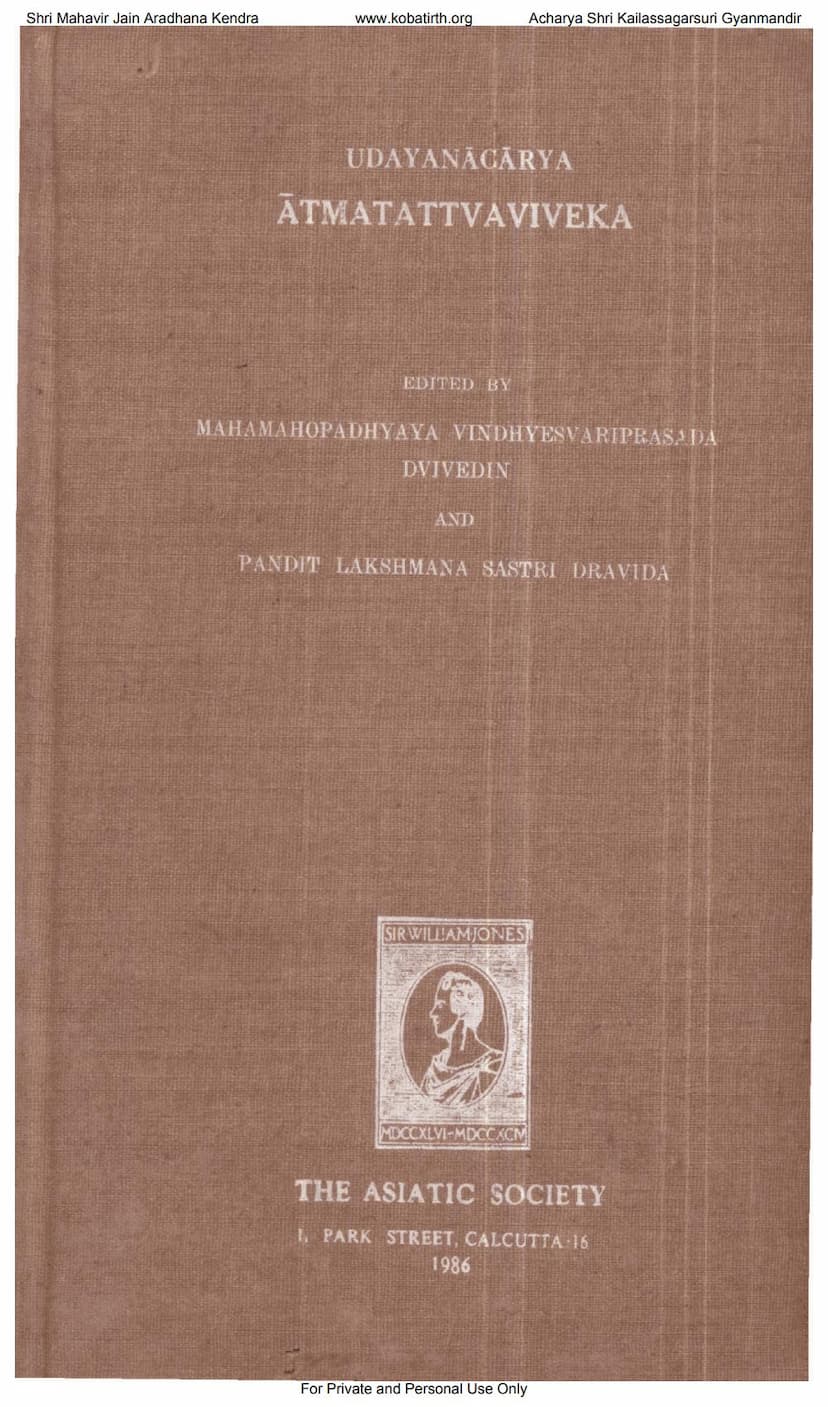Atmatattva Vivek
Added to library: September 1, 2025

Summary
The text you've provided is an excerpt from "Atmatattvaviveka" by Udayanacharya, edited by Mahamahopadhyaya Vindhyesvariprasada Dvivedin and Pandit Lakshmana Sastri Dravida, and published by The Asiatic Society. This particular edition is a reprint from 1986 of the original publication which likely occurred between 1907 and 1939.
Here's a comprehensive summary of the provided text, focusing on the prefatory and introductory notes and the general structure of the work:
1. Title and Author:
- Title: Ātmatattvaviveka (आत्मतत्त्वविवेक)
- Author: Udayanācārya (उदयनाचार्य), a renowned Indian philosopher.
- Commentaries: The text includes commentaries by Śankara Miśra, Bhagiratha Thakkura, and Raghunātha Tārkikasiromaņi.
2. Publisher and Edition:
- Publisher: The Asiatic Society, Calcutta (now Kolkata).
- Publication Year: The provided copy is a reprint from 1986, of an edition originally published in 1939. The prefatory note from 1986 indicates that the book had gone out of print after its initial publication.
- Bibliotheca Indica Series: This work is part of The Asiatic Society's esteemed Bibliotheca Indica series, which aims to publish rare and important Sanskrit and other oriental texts.
3. Nature of the Work:
- The Ātmatattvaviveka is described as an important Nyāya treatise. The Nyāya school of Indian philosophy is known for its focus on logic, epistemology, and metaphysics, particularly in analyzing reality and establishing valid knowledge.
- Its primary purpose is the refutation of Buddhist conceptions of the Ātman (soul). Specifically, it aims to counter four major Buddhist theories:
- Kṣaṇa-bhanga (क्षणभङ्ग): The theory that everything is momentary or transient.
- Bāhyārtha-bhanga (बाह्यार्थभङ्ग): The theory that external objects lack objective reality.
- Guṇa-guṇi-bheda-bhanga (गुणगुणिभेदभङ्ग): The theory that there is no distinction between substance and its qualities.
- Anupalambha (अनुपलम्भ): The doctrine that what is not perceived does not exist.
- The ultimate goal of refuting these Buddhist views is to establish the existence of a permanent Ātman.
4. Structure of the Work:
- The book is divided into five sections:
- The first four sections are dedicated to the refutation of the four Buddhist theories mentioned above (Kṣaṇa-bhanga, Bāhyārtha-bhanga, Guna-guṇi-bheda-bhanga, and Anupalambha). These are referred to as 'vādas' in the edition.
- The fifth section is dedicated to the positive exposition of Udayanācārya's own views and the establishment of the permanent soul. This section is termed "Svamatasthāpana" or "Siddhānta" (सिद्धान्त). The author himself calls this part "Ātmasadbhāvapramāṇa" (आत्मसद्भावप्रमाण) on page 743.
- The structure generally includes: an introductory verse (Mangala - मङ्गलम्), a short introduction (Pratijñā - प्रतिज्ञा), the four refutatory sections (Paramatanirasana - परमतनिराकरण), the positive exposition (Siddhānta - सिद्धान्त), and concluding verses (Samāptivākyam - समाप्तिवाक्यम्). However, the edition notes that these divisions are not always clearly indicated in the page headings.
5. Editorial and Publication History:
- The editing process was a lengthy one, initiated in 1907 by Mm. Vindhyesvariprasada Dvivedin.
- Dvivedin died after the third fascicle was published.
- Pandit Lakshmana Sastri Dravida took over in 1924 and continued the work until his death in 1931, having seen the work through galley proof up to page 800.
- Dr. B. Ch. Chhabra completed the correction of the remaining galleys in 1935.
- The first editor, Vindhyesvariprasada Dvivedin, had intended to write a comprehensive introduction, which unfortunately was not found by the Asiatic Society.
- The publication in 1939 aimed to make this valuable Nyāya treatise available, as it was in high demand and had gone out of print. The 1986 reprint signifies its continued importance and demand among scholars and researchers.
6. Key Philosophical Arguments: The core of Udayanācārya's argument in the Ātmatattvaviveka revolves around establishing the soul's (Ātman) existence and permanence against Buddhist criticisms. The refutation of Buddhist doctrines like kṣaṇa-bhanga (momentariness) is crucial for this. If all reality is momentary, then there can be no enduring self or soul. Udayanācārya, as a proponent of the Nyāya-Vaiśeṣika realist tradition, defends the existence of an eternal, unchanging soul that is distinct from the body and the mind.
In essence, "Ātmatattvaviveka" is a seminal work of Nyāya philosophy that systematically dismantles Buddhist arguments against the soul and reasserts the validity of the Ātman as a permanent, substantial reality. The publication history highlights its significance and the effort involved in bringing this complex philosophical text to a wider audience.